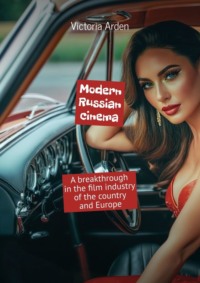Читать книгу: «Modern Russian cinema. A breakthrough in the film industry of the country and Europe»
© Victoria Arden, 2025
ISBN 978-5-0067-8628-8
Created with Ridero smart publishing system
This book is an analytical study of the renaissance and transformation of Russian cinema in the 21st century. She examines how Russian cinema overcame the crisis of the 1990s, adapted to new economic, technological and cultural realities, and once again became a significant force both in the domestic market and in the international arena. The book is not a collection of reviews or laudatory odes, but an objective, structured analysis: what factors contributed to the breakthrough, how the language of cinema is changing, what role the audience, the state and festivals play. The book is intended for moviegoers, students, directors, producers, and anyone interested in culture, media, and modern Russia.

Introduction: From crisis to rebirth
After the collapse of the Soviet Union, Russian cinema found itself in a state of deep crisis. The system, which in the previous era was centralized, state-owned, based on a powerful infrastructure of film studios, subsidies and compulsory rental, collapsed along with the state that supported it. In the 1990s, film production dropped to a minimum. Many film studios were forced to rent out their pavilions, redevelop or close. The technical base was outdated, the equipment was out of order, the staff went to other areas or abroad. The film industry has lost not only its means of production, but also its economic model.
During the same period, the behavior of the audience changed dramatically. People stopped going to cinemas. The reason was not only the falling standard of living, but also the lack of interesting content. The box office was dominated by cheap comedies, low-quality crime films and, more importantly, a huge stream of foreign, mostly American, blockbusters. They offered entertainment, professional installation, high technical level – everything that the domestic production lacked. The viewer, faced with a choice, preferred quality and entertainment. Cinemas were emptying, and cinema began to be perceived as an archaic, unprofitable art form. It seemed that cinema in Russia was experiencing not just a recession, but a complete disappearance.
However, by the late 1990s and early 2000s, processes began that gradually led to a turning point. First of all, it was a general economic upswing. The stabilization of the financial system, income growth and the development of consumer culture have created favorable conditions for the revival of the industry. People started spending money on leisure activities again, including going to the cinema. At the same time, the active construction of modern cinemas with several halls, comfortable armchairs, high-quality sound and screens began. It changed the viewing experience itself, making it attractive and comfortable. The cinema has ceased to be just a place to show a movie – it has become a part of urban culture, an entertainment center where people go not only for the sake of the film, but also for the sake of the atmosphere.
Another important factor was the changing interests of the audience. After a period of cultural import, the viewer began to show interest in his own history, national identity, and topics that related specifically to his reality. People wanted to see their own stories on the screen, not others’, about the war, about family, about everyday life, about heroes with whom they could associate themselves. This request was also supported by the government, which began to see cinema not only as a business, but also as a tool for shaping public sentiment, patriotism and cultural identity. Government support, although not always uniform, has become an important incentive for launching ambitious projects, especially in the genre of historical and military dramas.
In this book, a «breakthrough» is not just an increase in box office receipts, although this has become an important indicator. A breakthrough is a qualitative change in the entire film industry. This is a revival of interest in Russian cinema from both the audience and the creators. This is the appearance of films that are not inferior in technical level to their foreign counterparts, have a strong script, cause a wide public response and find a response outside the country. This is the recognition of Russian cinema at international festivals, participation in competitive programs, and receiving awards. This includes an increase in the number of viewers, an increase in the share of domestic films at the box office, and, most importantly, a change in perception: domestic cinema is no longer considered second-rate, but is perceived as a competitive product.
The purpose of this book is to understand how this breakthrough became possible. What economic, technological, cultural and political factors contributed to the revival of the film industry? What challenges had to be overcome: commercialization, censorship, dependence on government funding, competition with Hollywood? And what are the challenges facing Russian cinema today? Is it possible to talk about a new wave? Will it be possible to maintain a balance between commercial success and artistic quality? How to develop an author’s cinema without losing a mass audience? The book does not aim at laudatory odes, but at an objective analysis. She considers cinema as a complex socio-cultural phenomenon reflecting the state of society, its fears, hopes and search for oneself in the modern world.
Бесплатный фрагмент закончился.
Начислим
+12
Покупайте книги и получайте бонусы в Литрес, Читай-городе и Буквоеде.
Участвовать в бонусной программе
